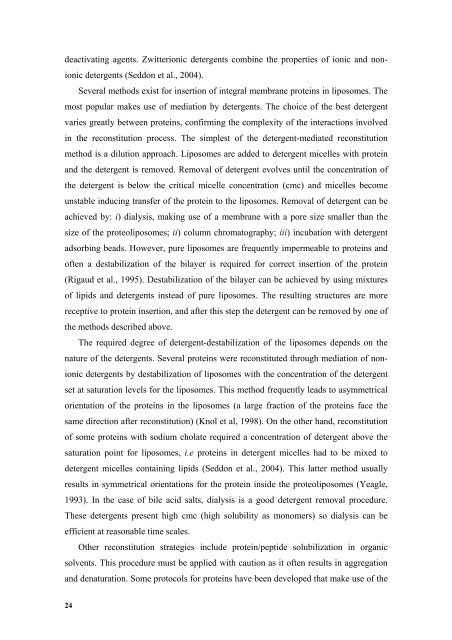Biophysical studies of membrane proteins/peptides. Interaction with ...
Biophysical studies of membrane proteins/peptides. Interaction with ...
Biophysical studies of membrane proteins/peptides. Interaction with ...
Create successful ePaper yourself
Turn your PDF publications into a flip-book with our unique Google optimized e-Paper software.
deactivating agents. Zwitterionic detergents combine the properties <strong>of</strong> ionic and nonionic<br />
detergents (Seddon et al., 2004).<br />
Several methods exist for insertion <strong>of</strong> integral <strong>membrane</strong> <strong>proteins</strong> in liposomes. The<br />
most popular makes use <strong>of</strong> mediation by detergents. The choice <strong>of</strong> the best detergent<br />
varies greatly between <strong>proteins</strong>, confirming the complexity <strong>of</strong> the interactions involved<br />
in the reconstitution process. The simplest <strong>of</strong> the detergent-mediated reconstitution<br />
method is a dilution approach. Liposomes are added to detergent micelles <strong>with</strong> protein<br />
and the detergent is removed. Removal <strong>of</strong> detergent evolves until the concentration <strong>of</strong><br />
the detergent is below the critical micelle concentration (cmc) and micelles become<br />
unstable inducing transfer <strong>of</strong> the protein to the liposomes. Removal <strong>of</strong> detergent can be<br />
achieved by: i) dialysis, making use <strong>of</strong> a <strong>membrane</strong> <strong>with</strong> a pore size smaller than the<br />
size <strong>of</strong> the proteoliposomes; ii) column chromatography; iii) incubation <strong>with</strong> detergent<br />
adsorbing beads. However, pure liposomes are frequently impermeable to <strong>proteins</strong> and<br />
<strong>of</strong>ten a destabilization <strong>of</strong> the bilayer is required for correct insertion <strong>of</strong> the protein<br />
(Rigaud et al., 1995). Destabilization <strong>of</strong> the bilayer can be achieved by using mixtures<br />
<strong>of</strong> lipids and detergents instead <strong>of</strong> pure liposomes. The resulting structures are more<br />
receptive to protein insertion, and after this step the detergent can be removed by one <strong>of</strong><br />
the methods described above.<br />
The required degree <strong>of</strong> detergent-destabilization <strong>of</strong> the liposomes depends on the<br />
nature <strong>of</strong> the detergents. Several <strong>proteins</strong> were reconstituted through mediation <strong>of</strong> nonionic<br />
detergents by destabilization <strong>of</strong> liposomes <strong>with</strong> the concentration <strong>of</strong> the detergent<br />
set at saturation levels for the liposomes. This method frequently leads to asymmetrical<br />
orientation <strong>of</strong> the <strong>proteins</strong> in the liposomes (a large fraction <strong>of</strong> the <strong>proteins</strong> face the<br />
same direction after reconstitution) (Knol et al, 1998). On the other hand, reconstitution<br />
<strong>of</strong> some <strong>proteins</strong> <strong>with</strong> sodium cholate required a concentration <strong>of</strong> detergent above the<br />
saturation point for liposomes, i.e <strong>proteins</strong> in detergent micelles had to be mixed to<br />
detergent micelles containing lipids (Seddon et al., 2004). This latter method usually<br />
results in symmetrical orientations for the protein inside the proteoliposomes (Yeagle,<br />
1993). In the case <strong>of</strong> bile acid salts, dialysis is a good detergent removal procedure.<br />
These detergents present high cmc (high solubility as monomers) so dialysis can be<br />
efficient at reasonable time scales.<br />
Other reconstitution strategies include protein/peptide solubilization in organic<br />
solvents. This procedure must be applied <strong>with</strong> caution as it <strong>of</strong>ten results in aggregation<br />
and denaturation. Some protocols for <strong>proteins</strong> have been developed that make use <strong>of</strong> the<br />
24















